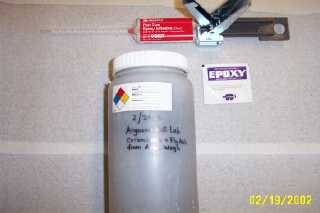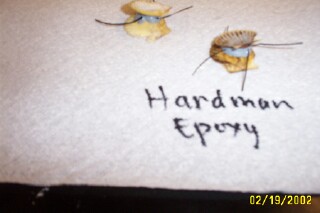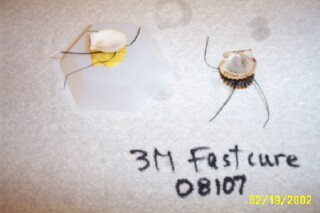Sample
preparation task 4, by E. Sichel on Feb. 19, 2002

Shown
are 3M Co. Automix Fast Cure Epoxy Adhesive 051135-08107 in
an applicator gun with a mixing nozzle to mix the two-part
epoxy, Hardman wet surface patching epoxy #04003, and a bottle
of experimental Ceramicrete (powder), developed by Dr. Arun
Wagh of Argonne National Laboratory.

Shown
are scallop shells with a piece of netting sandwiched between
them with Hardman wet surface patching epoxy.

Shown
are scallop shells and netting with 3M Co. FastCure Epoxy
051135-08107.
Samples
were prepared in a similar way to the procedure described
in the Martha's Vineyard Shellfish Project report. The pieces
of netting and the scallop shells were soaked in seawater
and then blotted dry with a paper towel. The adhesive was
applied to the shells and the netting was sandwiched between
the shells. The sandwich was left on the bench top for about
15 minutes in air. The sandwich was then immersed in a tray
of seawater, and the covered tray was stored in a refrigerator
at 34 degrees F.
The
Ceramicrete, which contains fly ash, was prepared by
adding 100 g of the Ceramicrete powder to 50 g of distilled
water. The mixture was stirred with a flat wooden stick for
30 minutes, intermittently. It was applied to the scallop
shells and netting, and the shell/netting sandwiches were
left to dry for 15 minutes in air on the bench. When the Ceramicrete
was applied, it had the consistency of ketchup. When the shells
and netting were immersed in a tray of seawater, the top shell
immediately came loose, and the Ceramicrete began to disperse
into a solution with the seawater. I conclude that the Ceramicrete
should be left to dry until it has a putty-like consistency
before it is applied to the scallop shells. This will be tried
in a future experiment.
A
stainless steel fixture was prepared for strength testing
with the Ceramicrete bonding the two pieces of steel shim
stock together for a tension test. The fixture was left to
cure in air. It will not be immersed in water.
The
adhesive bonds will be inspected in about two weeks.
Inspection
Report
The
samples were inspected on March 4, 2002 after 13 days in seawater
in the refrigerator. The refrigerator temperature dropped
to 25 degrees F, so the average temp. of storage is between
34 and 25 degrees F.
- 3M
Co. Fast Cure Epoxy Adhesive 051135-08107 formed an excellent
hard bond to the shells and the netting.
- Hardman
wet surface patching epoxy #04003 formed an excellent hard
bond to the shells and the netting.
- Ceramicrete
bonds came apart. A pool of Ceramicrete with embedded shells
did harden, but it is not strong enough to hold a shell
to scaffolding. Shells that had been pressed into the Ceramicrete
could be easily pried out of their position and the bed
of Ceramicrete was easy to break. It was slightly crumbly
under prodding.
|

